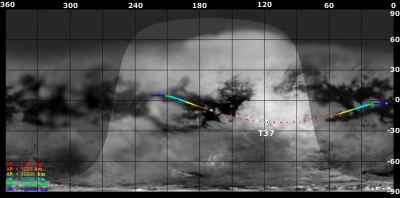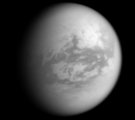Titan Flyby - 19 November 2007
16 November 2007
Forty-eight days after Cassini's last flyby, the spacecraft returns to Titan for its thirty-eighth targeted encounter: Titan-37. The closest approach to the moon occurs on Monday 19 November at 00:47:25 UTC at an altitude of 1000 kilometres above the surface and at a speed of 6.3 kilometres per second. The latitude at closest approach is 22° S and the encounter occurs on orbit number 52.This encounter is set up with two manoeuvres: an apoapsis manoeuvre on 1 November, and a Titan approach manoeuvre on 15 November. T37 is the second in a series of outbound encounters that will last until the end of the prime mission in July 2008, and it occurs less than two days after Saturn closest approach. This is the second in a series of seven Titan southern hemisphere encounters.
Science Activities
- Ion and Neutral Mass Spectrometer (INMS)
INMS will attempt to determine the composition and thermal structure of the atmosphere and ionosphere - Visible and Infrared Mapping Spectrometer (VIMS)
VIMS will perform Titan high resolution mapping for geology and composition - Composite Infrared Spectrometer (CIRS)
CIRS will carry out vertical temperature sounding of Titan's tropopause & stratosphere. These observations contribute to the team's objectives to both increase temporal coverage of global temperature maps while at the same time extending spatial coverage at the higher spectral resolutions used to detect new species and isotopes - Imaging Science Subsystem (ISS)
ISS will make a series of regional and global scale mosaics. The regional mosaic, northwest of Aderi, is complementary of T35 observations, which were northeast of Aderi - Ultraviolet Imaging Spectrograph (UVIS)
UVIS makes several slow scans across Titan's visible hemisphere to form spectral images. The objective is to obtain spectral images of Titan in the EUV and FUV to map the aurora and dayglow, to map hydrocarbon absorption, and to measure scattering and absorption by aerosols in the stratopshere. The UVIS slit will be scanned across Titan's disk to build up an image at many wavelengths - Dual Technique Magnetometer (MAG)
MAG will use data from the T36 and T7 flybys to look for temporal variations in the magnetic field in the wake/south polar region - Radio and Plasma Wave Science (RWPS)
RPWS will take advantage of the spacecraft's close wake passage near the southern boundary of the geometric wake. Cassini should be at a low enough altitude that the encounter will probably be an ionospheric pass rather than a wake pass. The RPWS objectives are to study the density and temperature of ionospheric electrons and to look for plasma waves that participate in the interaction of Saturn's magnetosphere with Titan
Table of Events
31 October 2007
| Time UTC | Time wrt Titan-37 |
Activity |
| 18:40:00 | -18d 06h | Start of sequence S35 which contains Titan-37 |
15 November 2007
| Time UTC | Time wrt Titan-37 |
Activity |
| 08:56:00 | -03d 16h | OTM #133 Prime. Titan-37 targeting manoeuvre. |
17 November 2007
| Time UTC | Time wrt Titan-37 |
Activity |
| 05:21:10 | -01d 19h | Descending ring plane crossing |
| 07:51:49 | -01d 17h | Saturn periapse, R = 3.8 RS, lat = -3°, phase = 145° |
| 08:42:00 | -01d 16h | OTM #133 Backup |
18 November 2007
| Time UTC | Time wrt Titan-37 |
Activity |
| 10:12:00 | -14h 35m | Start of the TOST segment |
| 10:12:00 | -14h 35m | Turn cameras to Titan |
| 10:42:00 | -14h 05m | Deadtime. 10 minutes 25 seconds long; used to accommodate changes in flyby time |
| 10:52:25 | -13h 55m | Titan atmospheric observations. Cloud map |
| 15:47:25 | -09h 00m | Titan atmospheric observations. Obtain vertical profiles of temperatures in Titan's stratosphere |
| 19:47:25 | -05h 00m | Titan atmospheric observations. Obtain information on surface & tropopause temperatures, and on tropospheric CH4 |
| 22:47:25 | -02h 00m | Transition to thruster control |
| 22:48:25 | -01h 59m | Titan atmospheric observations. Vertical sounding of stratospheric compounds on Titan, including H2O |
| 23:08:25 | -01h 39m | Titan atmospheric observations. Vertical aerosol sounding of Titan's stratosphere. |
19 November 2007
| Time UTC | Time wrt Titan-37 |
Activity |
| 00:02:25 | -00h 45m | Titan atmospheric observations. Vertical temperature sounding of Titan's tropopause & stratosphere |
| 00:32:25 | -00h 15m | Magnetosphere and plasma science. Part of the MAPS/TOST campaign. Determine atmospheric and ionospheric composition and thermal structure |
| 00:47:25 | +00h 00m | Titan-37 Flyby Closest Approach Time. Altitude = 1000 km, speed = 6.3 kms-1, 51° phase at closest approach |
| 04:36:19 | +03h 49m | Ascending Ring Plane Crossing |
| 00:56:25 | +00h 09m | Titan surface observations. High resolution mapping |
| 01:08:25 | +00h 21m | Transition off of thruster control |
| 01:31:25 | +00h 44m | Titan surface observations. High resolution mapping |
| 02:47:25 | +02h 00m | Titan surface observations. Regional map |
| 04:47:25 | +04h 00m | Titan atmospheric observations. Obtain information on surface & tropopause temperatures, and on tropospheric CH4 |
| 05:47:25 | +05h 00m | Titan surface observations. Global Map |
| 09:23:25 | +08h 36m | Titan atmospheric observations. Photometry observations |
| 09:47:25 | +09h 00m | Titan atmospheric observations. Obtain information on CO, HCN, CH4. Integrate on disk at airmass 1.5-2.0 |
| 14:47:25 | +14h 00m | Titan atmospheric observations. Obtain information on the thermal structure of Titan's stratosphere |
| 21:47:25 | +21h 00m | Titan atmospheric observations. Obtain information on the thermal structure of Titan's stratosphere |
20 November 2007
| Time UTC | Time wrt Titan-37 |
Activity |
| 00:06:34 | +23h 19m | Deadtime, 20 minutes and 26 seconds long. Used to accommodate. changes in flyby time |
| 00:27:00 | +23h 40m | Turn to Earth-line |
| 00:57:00 | +01d 00h | Playback of T37 Data. Madrid 70M |
Titan Ground Trace
 |
|
Image courtesy NASA/JPL/Space Science Institute |
The above image shows the ground trace of the Titan-37 flyby on a mosaic of Titan's surface, for a period of 32 hours around closest approach. The colour of the trace indicates Cassini's altitude above the surface. Blue: > 100 000 km, green: < 100 000 km, light blue: < 50 000, yellow: < 10 000 km, orange: < 5000 km, red: < 2000 km. The point of closest approach is marked T37 (Cassini at 1000 km altitude). Cassini approaches Titan over the equatorial region at 16 hours before closest approach (centre right in this image), and then continues to pass over Titan's southern hemisphere.
Observation Results
Cassini Instrument: Imaging Science Subsystem (ISS)


